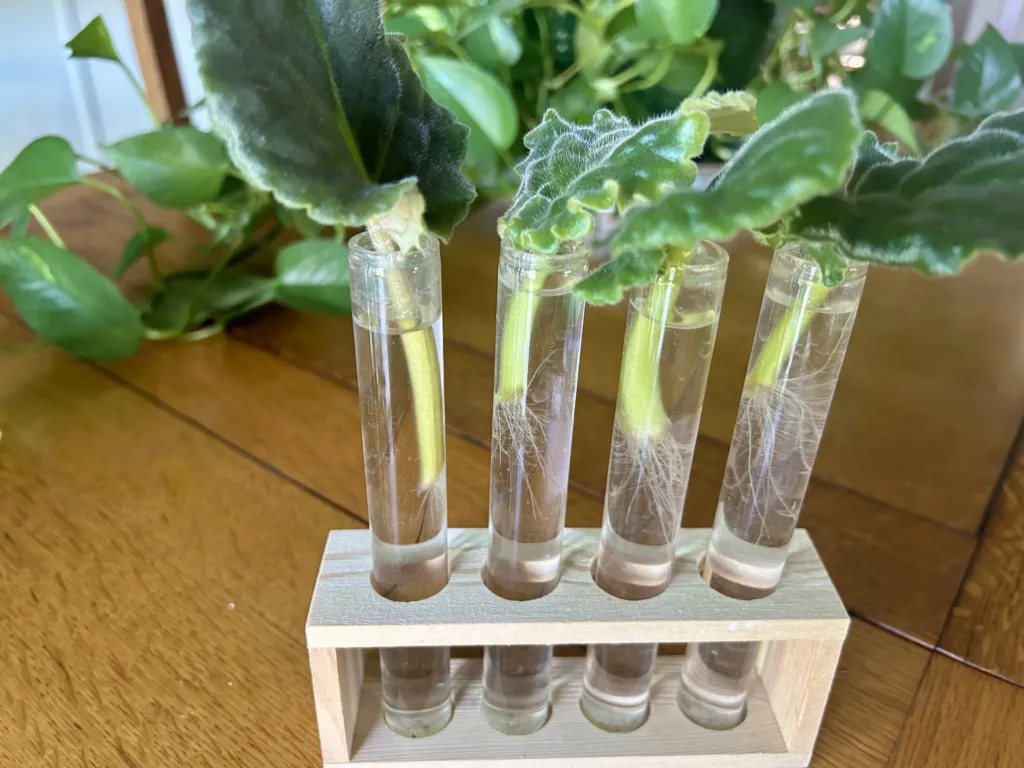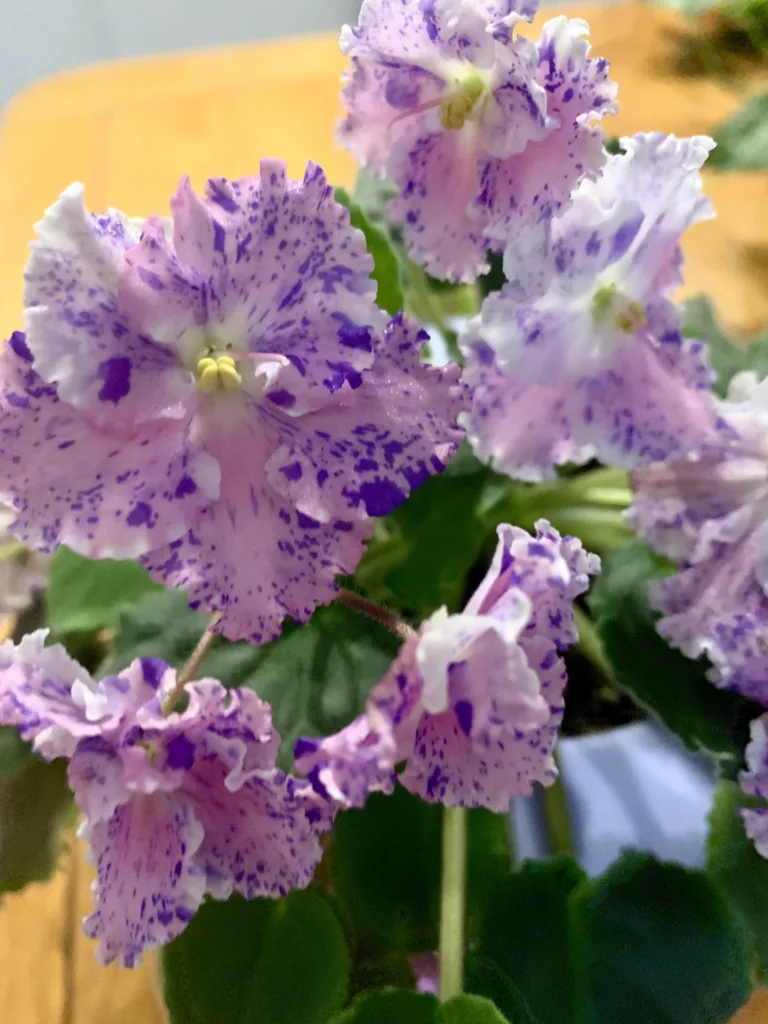African violets are one of the most popular houseplants due to their unique beauty and low-maintenance requirements. But if you’d like to create more plants from your African Violet collection then propagation is the answer and possible – with just a few simple steps. This is by far my favorite thing to do and I love sharing leaves with my friends so can all increase our collection! Below are some tips on how to propagate African violets easily at home.
Gather the supplies for African Violet Propagation
It’s important to use potting soil specifically designed for African violets, as a regular potting mix may contain too many nutrients that can harm delicate plants. You will also need a sharp knife or scissors, rooting hormone, various sizes of pots, baggies, or small domes for humidity. If you prefer the water propagation method then a vessel to hold the water will be needed.
Pot sizes needed for African Violet Propagation
It is important to choose the right pot for your African Violet propagation. You’ll want a smallish container with drainage holes and one that can fit inside another slightly larger one to create humidity. Another option would be to use baggies or miniature domes over the top of each pot.
Many of my friends start their new leaves in 2″ plastic pots but I just put mine directly into the 4″ pots and let them grow into them-I have started hundreds of Violets and never had an issue with this method. My reason is you are messing with the root balls less so minimizes the risk of damaging the young roots.
Identify the Healthiest African Violet Plant for Propagation
Look for healthy leaves that are thick, dark green, and without any signs of discoloration or disease. It’s important to choose a plant that is in its prime so you can ensure success with the propagation process.
How to prepare the African Violet for Propagation
It’s best to propagate African violets during the warmer months of spring or summer when the conditions are most favorable for growth. Gently remove any wilted or dead leaves from the plant and cut off any stems that have multiple blooms.
Different Types of Propagation for African Violets
There are two main ways to propagate African violets – through leaf cuttings or by growing new plants from their runners. Leaf cuttings involve snipping off healthy leaves and using them as the basis for a brand-new plant by either soil or water propagation. While runners grow out of the mother plant and can be disconnected and planted elsewhere.
Propagation into African Violet Soil
Using a sharp knife or scissors, carefully slice off a few healthy leaves from the middle row of leaves of the plant. The leaves should be at least two inches long with some stem or petiole attached. Using a sterile knife or scissors (I wipe mine with alcohol and let them air dry) cut the leaf end at an angle.
Dip the leaves in a rooting hormone and place them into a small pot of damp African violet potting soil. Cover with a plastic bag or small dome to create humidity. Place your newly potted leaves in a spot where they will receive indirect sunlight but not direct sun.
Propagating in Perlite or Vermiculite
If you prefer to propagate your African Violet leaves in Perlite or Vermiculite or a combination of both. Some even like to add a small amount of African Violet soil to the mix. Use a sharp knife or scissors, and snip off several healthy leaves from the middle row of leaves of the plant.
Dip them in rooting hormone and then place them into a vessel filled with damp perlite or vermiculite. Move your vessel to a spot that gets indirect sunlight and cover it with a plastic bag or small dome. Mist the leaves perlite/vermiculite with water, making sure not to overwater, as this can cause root rot and other diseases.
Propagating African Violets in Water

Snip off healthy leaves and place them in a vessel that contains water. There are some beautiful propagation stations for water. Make sure the petiole or stem of the leaves is securely submerged.
Change out the water every few days to prevent bacterial buildup, and then after about 3-4 weeks when you notice new roots appearing on the leaves, it’s time to transfer them into African Violet soil. Cover with a plastic bag or small dome to create humidity. Place your propagated plants in a spot where they will receive indirect sunlight but not direct sun.
Propagation by Runners or Plantlets
Runners or plantlets are fast-growing stems that grow from the base of the mother plant. They can be removed from the parent and planted directly into a new pot of soil. Fill in your new pot with African violet potting soil and create a small hole for planting. Carefully remove a runner from the parent, making sure to keep as much root system attached as possible. Place it in the pre-made hole and lightly press down on the soil to secure it. Cover with a plastic bag or small dome to create humidity. Place your propagated plants in a spot where they will receive indirect sunlight but not direct sun.
Monitor Progress and Transplant to a larger pot once root ball forms.
Once you’ve planted your African violet cuttings or runners, keep an eye on how they are progressing. Look for signs of new growth and a stronger root system. When the plants’ roots have grown into a solid ball, it’s time to transplant them into a larger pot with fresh soil. Follow the same steps for transferring your plantlets or cuttings into the new pot. Make sure to water them thoroughly after transplanting and keep in mind that it may take a few weeks before they start blooming again.
Continue Care of the African Violet Plant once rooted
Once you’ve successfully propagated African violets, it’s important to continue to care for them regularly. Water the plants when the soil feels dry and add fertilizer with each watering, as African violets need added nutrients to stay healthy.
Make sure to keep in indirect sunlight or fluorescent light and make sure that the temperature of the room is warm (60-75°F) and humid (around 50%) – an ideal environment for African violets. If the leaves start to become yellow or the flowers fall off, this could be a sign of too much fertilizer.
Keep an eye out for pests such as mealybugs or aphids and treat them with insecticidal soap if needed. With proper care, you’ll be able to enjoy blooming African violets for years to come!
Conclusion on How to Propagate African Violets
Propagating African violets can be a fun and rewarding experience. Whether you choose to propagate by leaf cuttings or plantlets, in water or soil, it’s important to keep in mind that each method takes patience and the right environment for success. With the proper care and attention, you’ll be able to enjoy your African violets for years to come!
Play around with the different propagation methods and see which one you have the best success with. I have friends that swear by African Violet soil only and others who only use Perlite or Vermiculite. And myself I start all mine in water, once roots form I transplant them to a pot of African Violet soil.
Once you get your method down, then begin trading leaves with friends and your new African Violet obsession has started!
Please be sure to check out my Gardening Blog Post Page for more tips on all types of gardening. Including Seed Starting, Orchids, Water Gardening, Coldframe Gardening, Indoor Bulb Gardening, Hydroponics, Container Gardening, Mums, Herbs, African Violets, planting Bulbs, Flower Gardening, Vegetable and Fruit Gardening, Indoor Houseplants of all kinds, Cactus, Succulents, Hanging plants, Deer resistant plants and even Bird, Bee, Butterfly and Hummingbird Gardens!

